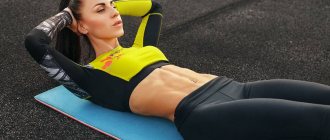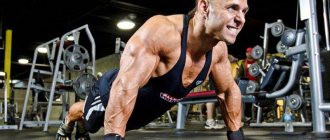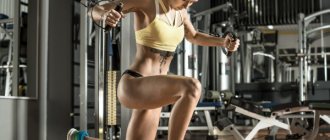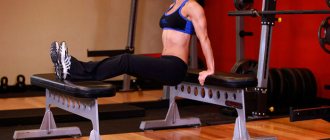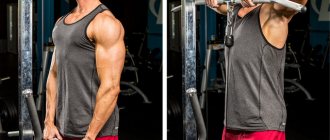A little anatomy
The area under consideration consists of four main departments:
- pectoralis minor and major muscles;
- subclavian;
- serrated
The developed large muscle is responsible for the size of this area. The small one is located immediately below the large one, its development helps to emphasize the convexity and relief of the chest.
Upper chest workouts are aimed at developing the large muscle while simultaneously loading its clavicular area and deltoids. The harmonious development of this entire zone can only be achieved through a properly designed training program.
The large muscle performs the following functions:
- bringing the arm to the body;
- moving the arm away from the body;
- assistance in the process of bending the arm and pulling the body up.
Thus, to develop this area, it is necessary to perform exercises related to the main function of the pectoralis major muscle. Therefore, the training is based on various push-ups, barbell and dumbbell presses.
Muscle failure factor
Very often, those who work out in the gym are faced with the problem that the muscles do not grow and there is no visible result. Most often this is due to poor nutrition, because in order to gain muscle mass, you need to follow proper nutrition.
But more often a mistake is made when we still have the strength to repeat the exercise, but we don’t do it.
To speed up muscle growth, perform all exercises until you lose all strength. Thus, the muscles will receive microdamage and stimulate themselves to recover as quickly as possible.
An excellent option for development would be push-ups for the upper pectoral muscles. They will strengthen your chest and back.
Workout Features
In general, pumping up the upper chest is quite simple. For these purposes, you need to perform only a few exercises. However, to achieve a good result, you need a comprehensive approach to developing the entire upper body.
- At home, dumbbells and push-ups are used; in the gym, barbell presses are used. To effectively work out the entire targeted area, complex work is required, consisting of basic pressing exercises and isolated loads.
- You can add exercises for the front delts to your training plan. This will not only enlarge your breasts, but will help achieve harmonious development of the entire upper body. You cannot pump up your chest without working out your deltas, otherwise after just a few weeks of regular training you will notice a noticeable lag in the development of the shoulder girdle. This explains why any workout should begin with basic exercises, which also involve the anterior deltoids.
- You can’t train only the upper part; you definitely need to add exercises to the lower part of this zone. If this is not done, the target muscle will indeed increase in size, but will lack definition and convexity. At the same time, working only on the pectoralis minor muscle can lead to a visual narrowing of the area, so it is recommended to work both zones during one workout.
You can devote separate days to training, or combine them with a load on your back, shoulders and arms. There is no universal plan; when drawing up a program, it is taken into account which muscles are lagging behind in development - the main emphasis is placed on them. Thus, complex loads on several zones at once are recommended for a beginner, but an experienced athlete can purposefully load only the lagging zones throughout the entire training session.
Incline Dumbbell Press
The second most important multi-joint exercise for the upper chest. Dumbbells allow you to increase the amplitude of movement of the projectile, and also involve stabilizer muscles to a greater extent. In addition, the load on each half of the body is equal, in contrast to the barbell, in which the load is distributed between the weakest and strongest halves of the body. In addition, there is a unilateral version of the dumbbell press - the one-arm press. It will come in handy if one breast lags behind the other in development. Typically, the total weight of the dumbbells will be 25% lower than the weight on the barbell, however, due to the increased range of motion, the load may be higher. Hands with dumbbells at the top point of the amplitude should be parallel to each other. The hands should be held in the same way as in the barbell press, but you can also turn them inward; with this option, the middle part of the pecs will also be connected, which we do not need. You should avoid placing your hands too wide at the lower point of the amplitude, as this can lead to sprains; your forearms should be perpendicular to the floor, without sagging outwards or inwards. The angle of inclination is the same as for the barbell press.
Basic exercises
The upper chest is actively involved when performing exercises on an incline bench - barbell or dumbbell presses. Dumbbell flyes will help stretch this muscle, thereby increasing its endurance and giving it “reserve” for further hypertrophy. But the classic barbell press on a flat bench and ordinary push-ups with arms wide apart are of little use - when doing so, the lower chest is primarily loaded. Fans of push-ups need not despair, because this basic exercise can be slightly modified to further target the desired area.
Barbell bench press
The technique is not much different from the classic bench press, and has only one important nuance - the angle of the bench. It should be from 30 to 450 so that the emphasis shifts specifically to the work of the upper part of the pectoralis major muscle. The angle of the bench depends on the experience of the athlete. For beginners, it is enough to set the bench at 300; as physical performance increases, the angle increases.
The technique is as follows.
- Lie down on a bench, place your hands on the bar with a regular overhand grip, but taking it in a lock. Place your hands at shoulder width or slightly wider.
- Remove the bar from the rack, elbows out to the side, feet firmly pressed to the floor.
- Lower the barbell to nipple level. As you exhale, press the barbell upward in one powerful movement, fully straightening your arms.
The movement should be accentuated and intense. You need to lower the barbell smoothly, but push it to the maximum, while exhaling sharply.
By changing the grip width you can change the load. A grip narrower than the shoulders works the central zone, shoulder-width - the load is distributed evenly, wider than the shoulders - the emphasis is on working the outer part of the upper chest and deltoids. The best option is to change your grip every workout to achieve harmonious development of the entire targeted area.
Dumbbell press
The basic principles are the same as when working with a barbell - the correct angle of the bench and the intensity of movement. Interestingly, the dumbbell press is more effective at developing the target area than the barbell. This is due to the fact that dumbbells are generally uncomfortable to hold, which means the body will be more tense. In addition, working with dumbbells requires less working weight than barbell bench press.
- Set the inclination of the bench within 30-400. The optimal angle of inclination and weight of dumbbells can only be determined experimentally by doing one approach in different variations.
- Take dumbbells in both hands, grip away from you. Lower your elbows below your shoulders, spread wide. Press your feet to the floor, buttocks do not leave the bench.
- As you inhale, lower the dumbbells to your nipples, then hold your breath and, with a powerful exhalation, squeeze them up until your arms are fully straightened.
At the top point, you should bring your arms together so that the dumbbells touch. This movement will help to put even more stress on your chest and will also increase the load on your midsection. As a result of performing this fairly simple exercise, the middle and outer areas of the chest, triceps and deltoids are effectively worked out.
Dumbbell fly
You should definitely add incline dumbbell raises to your training plan. This effectively stretches the muscles, thereby providing rapid mass gain. It is quite simple to perform, the main nuance is the low working weight. The purpose of the exercise is not to hammer the muscles, but to stretch them, and heavy weight in this case will only interfere and increase the risk of injury.
- Set the bench at an incline. Lie down so that your buttocks are pressed tightly to the surface and your feet are firmly on the floor.
- Take dumbbells in your hands with a hammer grip.
- Place your arms directly above your chest, then slowly spread them out to the sides as far as possible. Stay in this position for a second and gently shine your hands together.
As you raise your arms, you can rotate your wrists to rotate the dumbbells. This helps to engage the deltoids and triceps more. This movement is not necessary; you can perform the placement by fixing the hands in one position.
Push ups
You can pump up your upper chest at home with push-ups. However, classic push-ups are not suitable for these purposes. You can shift the emphasis to the upper part by changing the position of the body - the legs should be located above the body and head. There are several options here - use a chair, bench, or simply rest your feet against the wall.
The technique is as follows. Place your legs so that they are higher than your body. Place your hands under the shoulder line. Tighten your abs and buttocks, inhale and bend your elbows, lowering your body. Then exhale, at the same time extending your arms and pushing your body up.
At the gym, push-ups can be made more difficult by placing your feet in TRX loops. The load will increase significantly as the center of gravity changes.
The distribution of the load depends on the placement of the hands on the floor: the hands are narrower than the shoulders - the middle of the targeted zone works and the triceps are wider than the shoulders - the emphasis shifts to working the outer area.
Hummer press
And again, simulators help us! Not all gyms have such a useful exercise machine, but if you come across one, then you are just lucky! The hammer imitates a dumbbell press on an incline bench, while its arms themselves bring each other together at the top point of the amplitude. It turns out a kind of mixture of the effects of the dumbbell press and information in the crossover, but at the same time the stabilizer muscles are turned off. In the hummer it is very comfortable to perform presses with both hands simultaneously or alternately, which will add variety to the training process. Usually the angle of the bench is fixed, only the seat height is adjustable. All you have to do is set the desired weight, sit on the machine and press.
Working weight and number of repetitions
Having figured out how to pump up the upper part of the pectoral muscles, you should figure out the weight and the number of repetitions. When choosing a weight, everything is simple - you need to take as much as your physical fitness allows. For beginners, when working with a barbell, 15-20 kg is enough. Women can limit themselves to 10 kg or use an empty bar. Weight is added as overall endurance increases.
When starting out, it is recommended to do several approaches with different weights to determine the optimal working range. You need a weight with which the athlete can do 8 repetitions without much effort, and another 2-4 repetitions with noticeable muscle tension. The barbell press should be performed 8-12 times, 3-4 approaches.
The total weight of dumbbells is always selected slightly less than barbells. This is explained by the fact that using projectiles that are not connected by a bar is always more difficult. Beginners are advised to prepare several sets of dumbbells in 1 kg increments and determine the workload experimentally. To begin with, you should try dumbbells of 5, 6, 7 and 8 kg each. Women start with 3 kg. Perform 8-12 times, 3-4 sets.
With push-ups, everything is simple - 4 sets of 20 times. Beginners can start with three sets of 15 reps. After some time, the body will get used to such loads, so you will have to think about additional weights. In the gym you can use 5-10 kg weight plates, which should be placed on the area between the shoulder blades. At home, you can put dumbbells on your back.
Why did this happen?
Yes, very simple. Because the anatomy of our breasts has a very unusual structure.
As I said in the article about how to pump up your chest at home, the pectoral (pectoral) muscles are unique to some extent, because they are attached at different angles to the sternum and collarbone, FORMING THE LETTER “G”, which is why they need to be trained under different angles.
The UPPER PART occupies most of the pectoral muscles, so to a greater extent it determines the appearance of the WHOLE BREAST!
If we imagine in a very exaggerated way the ratio of the upper, middle and lower parts of the chest, then:
- TOP: 60%
- MIDDLE: 30%
- BOTTOM: 10%
Do you understand why I place the main emphasis on the upper part?
By the way, when working on an inclined bench (20-30 degrees), the middle part is also involved in the work! Those. you use almost the entire array of pectoral muscles.
The incline bench press is the so-called BODY PRESS, i.e. aimed specifically at muscle growth, and not at lifting maximum weight in all possible ways.
You most likely will not be able to squeeze out the same weight as on a horizontal bench, but in terms of muscle growth, this will be the BEST SOLUTION, because... uses almost the entire muscle mass of the chest.
Training plan
In fact, the exercises presented are a ready-made training plan. They need to be performed sequentially, in one workout. If the overall load is not enough, you can supplement the training with deltoids, biceps or triceps.
It is not recommended to combine with exercises for the lower chest area. This is explained by the fact that they are very similar, the only difference is the inclination of the bench when pressing and the position of the body during push-ups. Thus, it is better to devote one workout a week to working only the upper part, and load the rest of the muscles in this area on another day.
Set aside two days for breastfeeding
Experts advise working on the chest muscles once every five days . It is advisable to train on this schedule for chest exercises for at least 6–8 weeks. After this, you can include a second day in your training program to work out your chest , or more precisely, its upper part. For better results, you can supplement the second session with new exercises from month to month, experimenting with the angles of the bench during bench presses.
Principles of chest training for muscle growth
To ensure that your efforts are reflected in the volume of your pectorals, take note of several rules of training and nutrition. Without them, exercises may be ineffective.
- Nutrition. It is very important to get enough protein foods (meat, fish, dairy products, cottage cheese), since muscles are built from protein. The second point is a calorie surplus: the total calorie content of your diet for the day should be higher than the body’s needs.
- Progress in loads. If you constantly do the exercise with the same weight, there will be no result. To grow, you need to constantly increase the level of load - increase the weight so that the muscles grow. For push-ups, it is best to use weights.
- Don't ignore upper chest exercises. Poorly developed upper pectoral muscles are a common problem faced even by those who have been training for a long time. To avoid it in the future, include military presses and incline presses in your program now.
- You don't need to train too often. Do not train your pectorals for 2 days in a row, give your muscles a rest. With sufficiently heavy training, two workouts per week will be enough.
- Another golden rule is to warm up . It will help you avoid injuries and at the same time recover better.
chestpectoralworkout at home


